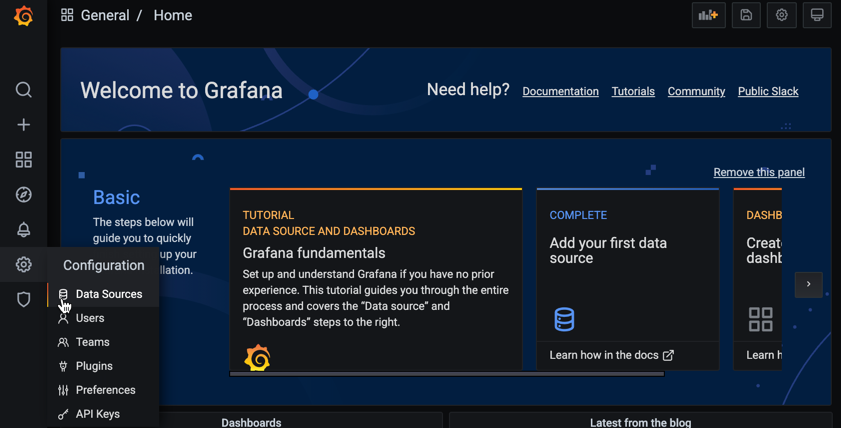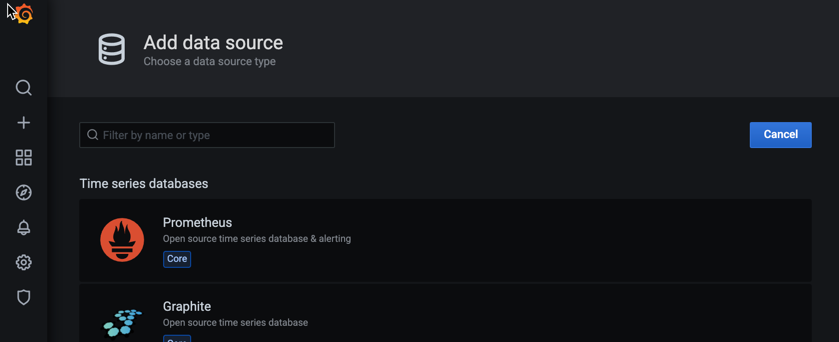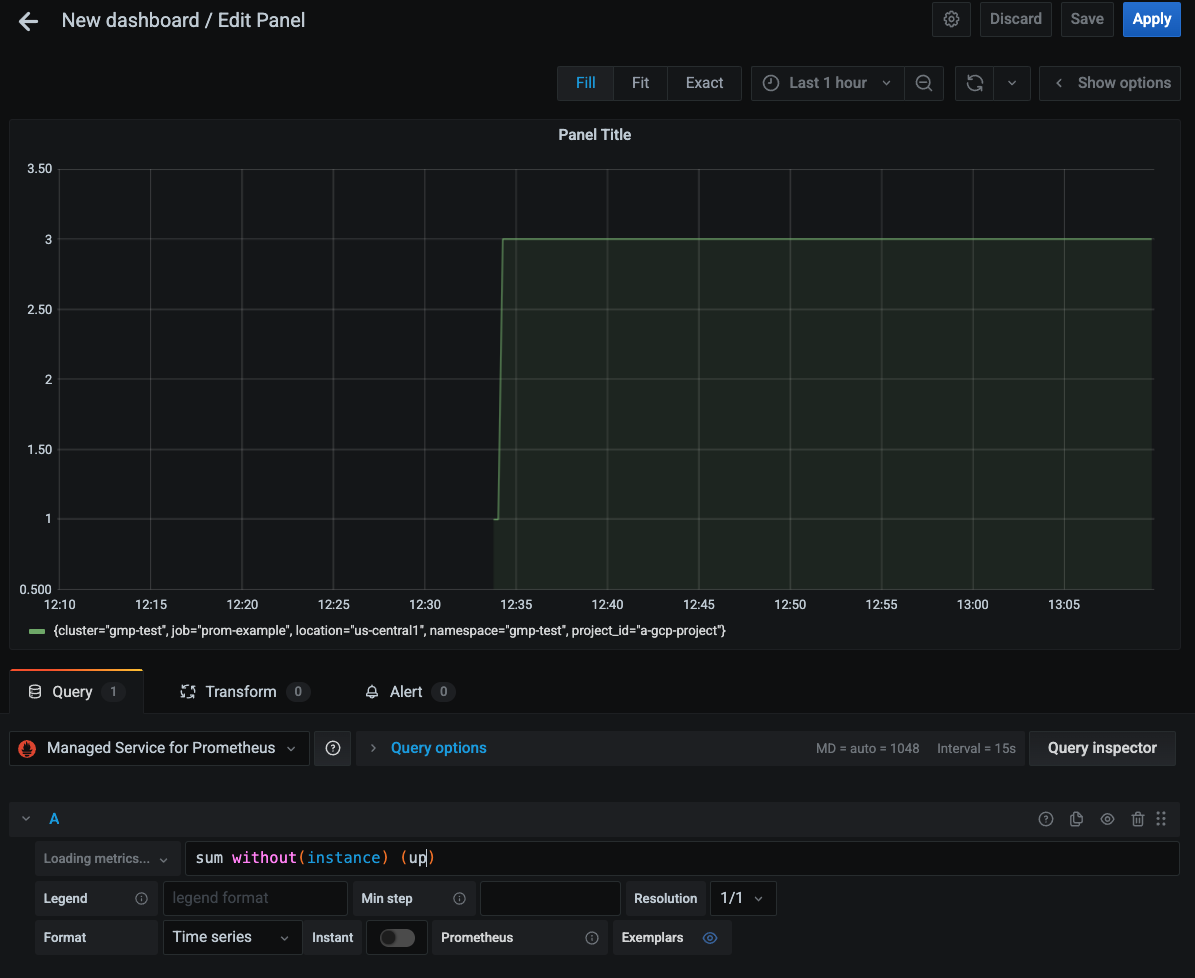Checkpoints
GMP deployment
/ 33
Prometheus metric
/ 33
Grafana data source
/ 34
Migrate Existing Prometheus Monitoring Workloads to Google Cloud
GSP1025
Overview
With self-deployed data collections, you manage your Prometheus installation as usual. The only difference from upstream Prometheus is that you run the Managed Service for Prometheus drop-in replacement binary instead of the upstream Prometheus binary.
In this lab, you will explore how to use Managed Service for Prometheus in a self-deployed data collection mode. You can also utilize managed data collection as well.
Objectives
In this lab, you will learn how to:
- Deploy the Managed Service for Prometheus
- Create a self-managed data collection for scraping metrics
- Use Grafana to query Prometheus metrics data
Setup and requirements
Before you click the Start Lab button
Read these instructions. Labs are timed and you cannot pause them. The timer, which starts when you click Start Lab, shows how long Google Cloud resources will be made available to you.
This hands-on lab lets you do the lab activities yourself in a real cloud environment, not in a simulation or demo environment. It does so by giving you new, temporary credentials that you use to sign in and access Google Cloud for the duration of the lab.
To complete this lab, you need:
- Access to a standard internet browser (Chrome browser recommended).
- Time to complete the lab---remember, once you start, you cannot pause a lab.
How to start your lab and sign in to the Google Cloud console
-
Click the Start Lab button. If you need to pay for the lab, a pop-up opens for you to select your payment method. On the left is the Lab Details panel with the following:
- The Open Google Cloud console button
- Time remaining
- The temporary credentials that you must use for this lab
- Other information, if needed, to step through this lab
-
Click Open Google Cloud console (or right-click and select Open Link in Incognito Window if you are running the Chrome browser).
The lab spins up resources, and then opens another tab that shows the Sign in page.
Tip: Arrange the tabs in separate windows, side-by-side.
Note: If you see the Choose an account dialog, click Use Another Account. -
If necessary, copy the Username below and paste it into the Sign in dialog.
{{{user_0.username | "Username"}}} You can also find the Username in the Lab Details panel.
-
Click Next.
-
Copy the Password below and paste it into the Welcome dialog.
{{{user_0.password | "Password"}}} You can also find the Password in the Lab Details panel.
-
Click Next.
Important: You must use the credentials the lab provides you. Do not use your Google Cloud account credentials. Note: Using your own Google Cloud account for this lab may incur extra charges. -
Click through the subsequent pages:
- Accept the terms and conditions.
- Do not add recovery options or two-factor authentication (because this is a temporary account).
- Do not sign up for free trials.
After a few moments, the Google Cloud console opens in this tab.

Activate Cloud Shell
Cloud Shell is a virtual machine that is loaded with development tools. It offers a persistent 5GB home directory and runs on the Google Cloud. Cloud Shell provides command-line access to your Google Cloud resources.
- Click Activate Cloud Shell
at the top of the Google Cloud console.
When you are connected, you are already authenticated, and the project is set to your Project_ID,
gcloud is the command-line tool for Google Cloud. It comes pre-installed on Cloud Shell and supports tab-completion.
- (Optional) You can list the active account name with this command:
- Click Authorize.
Output:
- (Optional) You can list the project ID with this command:
Output:
gcloud, in Google Cloud, refer to the gcloud CLI overview guide.
Task 1. Deploy GKE cluster
- Deploy a basic GKE cluster to setup lab:
2.. Create namespace gmp-test:
Task 2. Deploy application
This example application emits Prometheus metrics on its metrics port. The application uses three replicas.
Task 3. Deploy Prometheus
- Run the following command to ingest a metric:
If the deployment was successful then you should see a similar output to the following. Wait for the status of all pods to be Running.
Task 4. Prometheus metrics
Run the following commands to verify that you can see metrics by using the Prometheus metrics API.
- Set environment variable:
- Use the following curl command:
- Forward the port to see the Prometheus metrics UI:
- In cloud shell editor use the web preview icon to change the port to 9090 then view the metrics.
Task 5. Deploy Grafana
- Clone kube-prometheus repo:
- Change directory to the kube-prometheus:
- Run the following commands to deploy an ephemeral Grafana deployment:
- Forward the port to see the Grafana UI:
- In cloud shell editor use the web preview icon to change the port to 3001 then view the Grafana dashboard.
Task 6. Grafana
-
Log in to Grafana using the username admin and password admin.
-
Click Skip when asked to enter new password.
Task 7. Configure data source
To query Managed Service for Prometheus in Grafana by using the Prometheus UI as the authentication proxy, you must add new data source to Grafana. To add a data source for the managed service, do the following:
-
Go to your Grafana deployment, for example, by browsing to the URL
http://localhost:3000to reach the Grafana welcome page. -
Select Configuration from the main Grafana menu, then select Data Sources.
- Select Add data source, and select Prometheus as the time series database.
-
In the URL field of the HTTP pane, enter the URL of the Managed Service for Prometheus frontend service. If you configured the Prometheus UI to run on port 9090, then the service URL for this field is
http://frontend.gmp-test.svc:9090. -
In the HTTP Method field, select GET.
- Click Save & Test, and look for the message "Data source is working".
Task 8. Grafana chart
You can now create Grafana dashboards using the new data source. You can also redirect existing dashboards to the new data source. The following screenshot shows a Grafana chart that displays the up metric.
Congratulations
You have learned how to deploy the Managed Service for Prometheus, create a self-managed data collection for scraping metrics, and use Grafana to query Prometheus metrics data.
Next steps / Learn more
Find more information on considerations to make when choosing a managed vs. self-managed data collection in the Data collection with Managed Service for Prometheus documentation
Google Cloud training and certification
...helps you make the most of Google Cloud technologies. Our classes include technical skills and best practices to help you get up to speed quickly and continue your learning journey. We offer fundamental to advanced level training, with on-demand, live, and virtual options to suit your busy schedule. Certifications help you validate and prove your skill and expertise in Google Cloud technologies.
Manual Last Updated April 18, 2024
Lab Last Tested October 17, 2023
Copyright 2024 Google LLC All rights reserved. Google and the Google logo are trademarks of Google LLC. All other company and product names may be trademarks of the respective companies with which they are associated.





